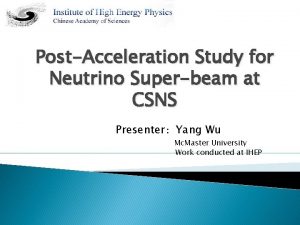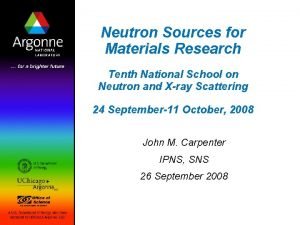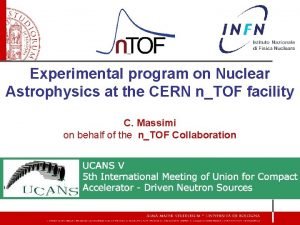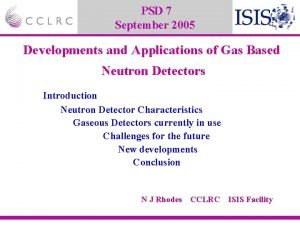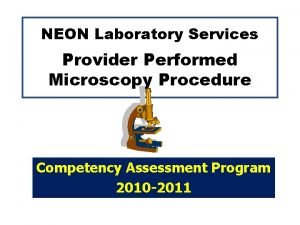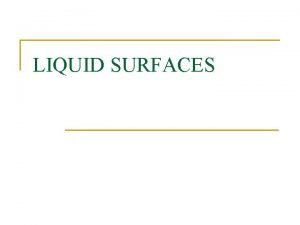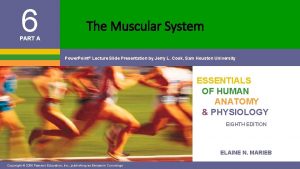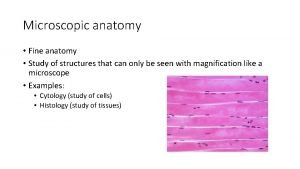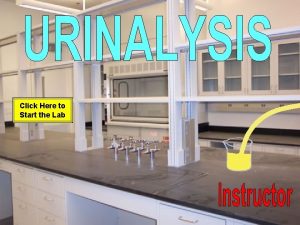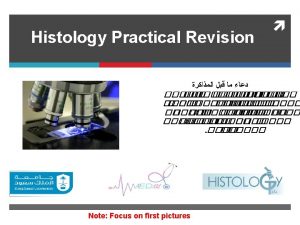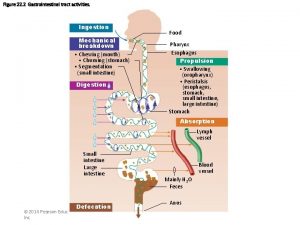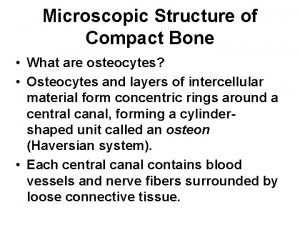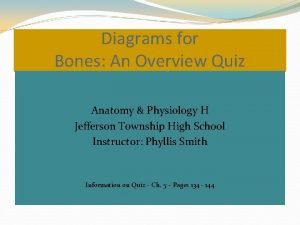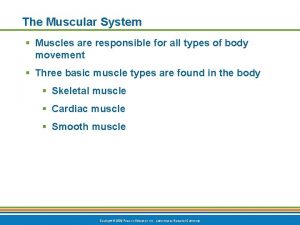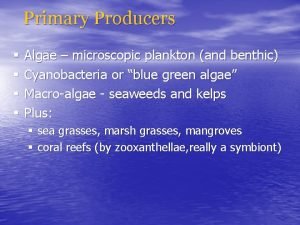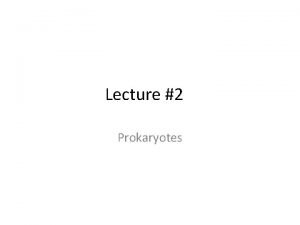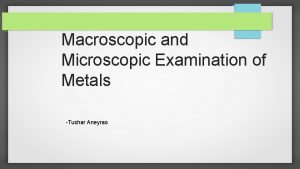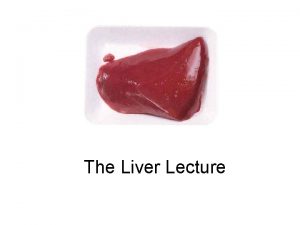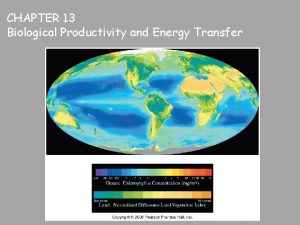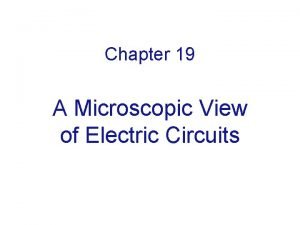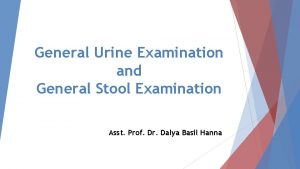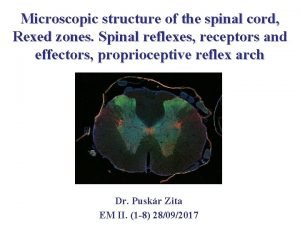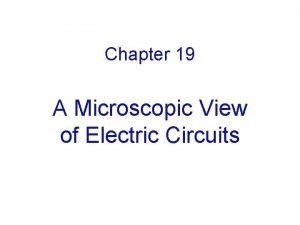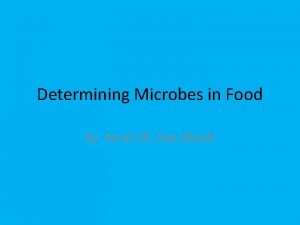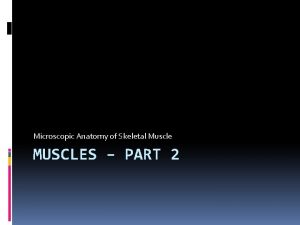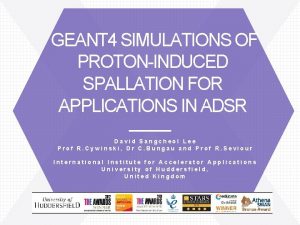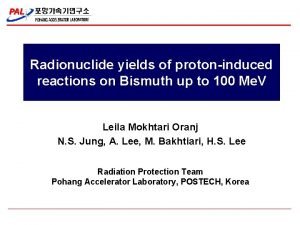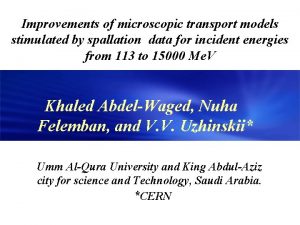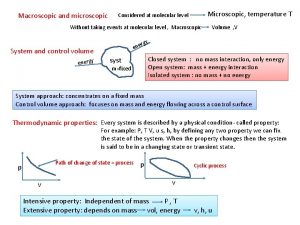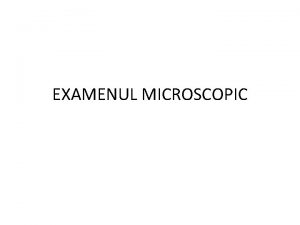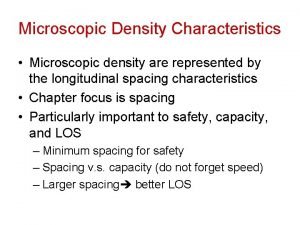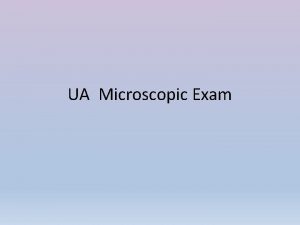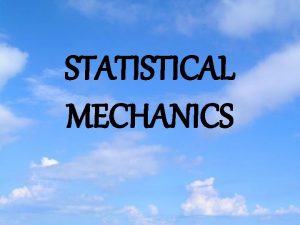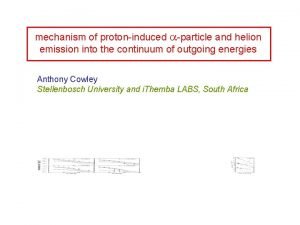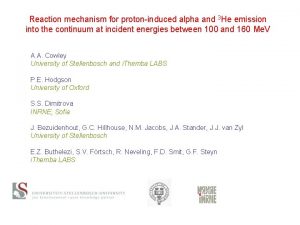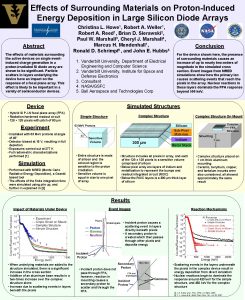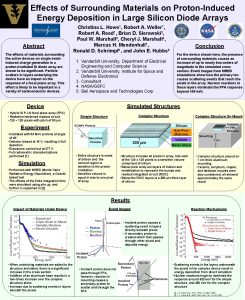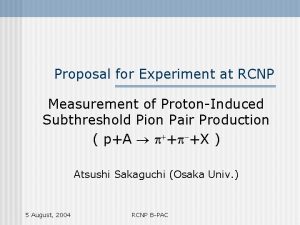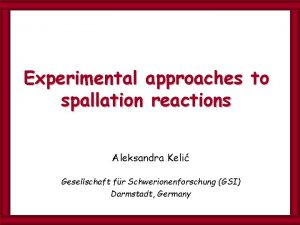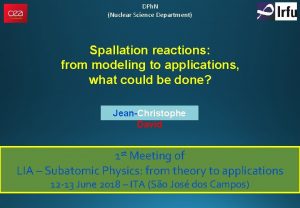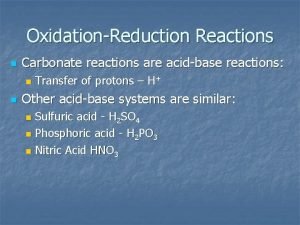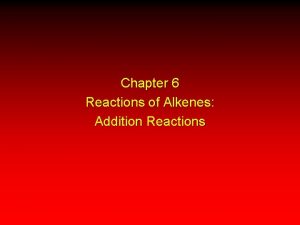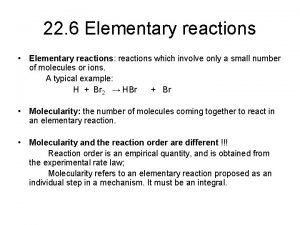Microscopic description of protoninduced spallation reactions with the
































- Slides: 32

Microscopic description of proton-induced spallation reactions with the Co. MD (Constrained Molecular Dynamics) model Angeliki Asimakopoulou, George A. Souliotis Physical Chemistry Laboratory, Department of Chemistry University of Athens, Greece Aldo Bonasera INFN, Catania, Italy, Texas A &M University, Texas, USA Martin Veselsky Io. P, Bratislava, Slovakia 25 th Symposium of the Hellenic Nuclear Physics Society, NCRS “DEMOKRITOS”, Athens, Greece, 3 -4 June 2016

Outline v Motivation: applications of spallation reactions & understanding of the reaction mechanism v Description of theoretical Co. MD model v Comparison between experimental & theoretical results v Future work plan v Summary and conclusions

Applications of spallation Accelerator- driven systems (ADS) Energy amplification Transmutation of nuclear waste Sources (Facilities) of spallation neutrons Production of rare isotopes (ISOL facilities) Astrophysics (reactions induced by cosmic rays in interstellar medium)

Accelerator driven system (ADS) Ø High energy proton beam bombards a heavy metal target (Pb, Th, U) Ø A large number of neutrons is produced by spallation & Ø Directed to the subcritical core (e. g. Th, U) MYRRHA research reactor in Belgian Nuclear Research Centre

Spallation reaction mechanism

Description of theoretical Co. MD model Co. MD: Quantum Molecular Dynamics Model (Semiclassical) q The nucleons considered as gaussian wavepackets q Phenomenological interaction Ν-Ν (effective interaction) q Asymmetry potential Ν-Ν depending on the nuclear density § § (“standard”) (“soft”) q Application of Pauli Principle through appropriate restriction in the phase space q Recognition of fragment formation ( < 3. 0 fm) q Simulation of successive events (Monte Carlo approach)

p(500 Me. V) +

Comparison between theoretical results and experimental data: p(1000 Me. V) + Co. MD calculations Red line: standard Blue line: soft Black points: experiment Heavy Residue Fission fragment s Co. MD calculations agree with the experimental data T. Enqvist et al. , Nucl. Phys. A 686, 481 -524 (2001)

Comparison between theoretical and experimental results: p (500 Me. V, 1000 Me. V) + , Co. MD calculations: Red line: standard Blue line: soft 3 5 1 4 Black points: experiment 2 Y. Ayyad, J. Benlliure et al. , Phys. Rev. C 89, 054610 (2014) 1)J. L. Rodriguez et al. , Phys. Rev. C 90, 064606 (2014) 2)T. Enqvist et al. , Nucl. Phys. A 686, 481 -524 (2001) 3)B. Fernandez et al. , Nucl. Phys. A 747, 227 -267 5)A. V. Prokofiev, Nucl. Instr. Meth. A 463 557 -575 (2001) 4)K. -H. Schmidt et al. , Phys. Rev. C 87, 034601 (2005)

Fission cross section/residue cross section Co. MD calculations Red line: standard Blue line: soft High fissility 3 2 1 Modest fissility Low fissility 1)T. Enqvist et al. , Nucl. Phys. A 686, 481 -524 (2001) 2)B. Fernandez-Dominguez et al. , Nucl. Phys. A 747, 227 -267 (2005) 3)M. Bernas et al. , Nucl. Phys. A 725, 213 -253 (2003)

Neutron multiplicity Co. MD calculations Red line: standard Blue line: soft Spallation neutron multiplicities: 15 20 neutrons 1)B. Fernandez et al. , Nucl. Phys. A 747, 227267 (2005) 2)T. Enqvist et al. , Nucl. Phys. A 686, 481 -524 (2001) 3, 4)S. Leray et al. , Phys. Rev. C 65, 044621 (2002) 2 1 3 4

Neutron multiplicity Co. MD calculations: Red line: standard Blue line: soft M. Bernas et al. , Nucl. Phys. A 725, 213 -253 (2003)

Conclusions - Future work plan § § q § Ø Co. MD Calculations: Successful description of the complete dynamics of the spallation process Study of spallation observables: Mass yield curves, Fission/Residue cross sections Pre-scission, post-scission, total nucleon emission (especially neutrons) Future Plan: Systematic study of the above spallation observables Detailed comparison with experimental data Contribution of the present spallation study to the understanding of the reaction mechanism & to the practical applications (e. g. systematics of spallation neutrons)

Thank you!


Neutron multiplicity Co. MD calculations Red line: standard Blue line: soft

Comparison between theoretical and experimental results: p (500 Me. V, 1000 Me. V) + Co. MD calculations Red line: standard Blue line: soft Black points: experiment Y. Ayyad, J. Benlliure et al. , Physical Review C 89, 054610 (2014)

Fission neutrons Fission: n + 235 U = n + fragments 200 Me. V/n Sustain chain reaction available moderated by D 2 O (H 2 O)

Accelerator Transmutation of Waste (ATW) A significant proportion of wastes in used nuclear fuel is long- lived actinides (Np, Am, Cm) Following neutron capture heavy isotopes fission producing energy Bombardment of waste with intense neutron flux produced from spallation � Heavier elements fission into less dangerous species � Lighter elements are converted through neutron absorption

Spallation reactions Spallation is a nuclear reaction in which a high energy projectile interacts with a heavy nucleus High energy projectile interacts with target nucleons individually, as nucleon- nucleon collisions, inducing a succession of binary collisions on a time scale s. This is called intra- nuclear cascade Energetic neutrons, protons, pions and light particles are being emitted and others deposit their kinetic energy in the nucleus resulting in an excited residual in thermodynamical equilibrium, with few Me. V/nucleon Equilibrium stage: de-excitation of residual nucleus through • evaporation( n, p, d, a) on time scale • • fission into 2 fragments Fragmentation (residual nucleus breaks up fast into a large number of IMF’s

Spallation neutrons Spallation: 20 neutrons/Ge. V proton are created Fission: 2. 5 neutrons/fission event Spallation: p + heavy nucleus = 20 n + fragments 1 Ge. V e. g. W, Pb, U 23 Me. V/n Number of neutrons beam energy & mass number of target Spallation n energy: from tens of ke. V up to incident proton energy, maximum 2 Me. V Fission n energy: from thermal energies up to 10 Me. V, maximum 1 Me. V

New data






Recent Literature of spallation M. V. Ricciardi et al. , Phys. Rev. C 73, 014607 (2006) § Experimental study of (1 Ge. V/u) + p at the FRS in GSI § Formation of 254 isotopes in the range 7 ≤ Z ≤ 37 § Statistical code ABRABLA (abrasion- ablation) used for comparisons J. L. Rodriguez-Sanchez, J. Benlliure, et al. Phys. Rev. C 90, 064606 (2014) § Measurement of fission cross sections in + p at 370, 500, 650 Me. V/u at GSI § Description with INCL 4. 6 & ABLA 07 Y. Ayyad, J. Benlliure et al. , Physical Review C 89, 054610 (2014) § Measurement of total fission cross sections at 300 – 1000 Me. V § Experimental & theoretical study of + p (inverse kinematics) in GSI § Description of reaction with intranuclear cascade models (INCL 4. 6 (Liege') and ISABEL) & deexcitation codes (ABLA 07 and GEMINI++)

Recent Literature of spallation A. A. Kotov et al. , Physical Review C 74, 034605 (2006) § Measurement of fission cross sections , , , , & in energy range 200 -1000 Me. V § Detection of 2 fission fragments by 2 (PPAC) J. L. Rodriguez- Sanchez, J. Benlliure et al. , Physical Review C 91, 064616 (2015) § (500 Me. V/u) + p performed at GSI § Measurement of isotopic cross sections, velocities of ff (Z = 27 to Z = 52), mass yields § Identification of Z with MUSIC § Comparison of results with INCL 4. 6 + ABLA 07 code

Accelerator Transmutation of Waste (ATW) � � ATW: a variant of ADS Instead of fissile fuel there is a blanket containing the waste Nuclear waste (i. e. spent nuclear fuel): significant part is long-lived actinides (Np, Am, Cm) Transmutation of long- lived radioisotopes into stable or short-lived elements Possibility of safe storage

Spallation neutron sources: Applications and Facilities Ø Ø § § Neutrons as probe in condensed matter science (e. g. gain new insights into atomic disordering in complex metal oxides) Biology: Understanding new theories in Cellular Membrane organization (presence and formation of nanoscale lipid patches) simulation of lipid bilayer or cell membrane (understanding how viruses invade healthy cells) ESS, Lund, Sweden SINQ, Switzerland GEMS, Germany ISIS, UK SNS, Oak Ridge, USA LANSCE, Los Alamos, USA J-PARC, Japan

Comparison between theoretical and experimental results: p(100 - 1000 Me. V) + Co. MD calculations Red line: standard Blue line: soft Black points: experiment 2 1 1)M. V. Ricciardi et al. , Phys. Rev. C 73, 014607 (2006) 2)M. Bernas et al. , Nucl. Phys. A 725, 213 -253
 Spallation neutron source
Spallation neutron source Spallation neutron source
Spallation neutron source Spallation neutron source
Spallation neutron source Spallation neutron source
Spallation neutron source Chemistry unit 5 reactions balancing reactions worksheet
Chemistry unit 5 reactions balancing reactions worksheet Redox reactions half reactions
Redox reactions half reactions Section 2 classifying chemical reactions
Section 2 classifying chemical reactions Types of reactions
Types of reactions Chemical reactions section 2 classifying chemical reactions
Chemical reactions section 2 classifying chemical reactions Neonlab
Neonlab Capillary condensation
Capillary condensation Microscopic anatomy of skeletal muscle figure 6-2
Microscopic anatomy of skeletal muscle figure 6-2 Pdq definition forensics
Pdq definition forensics Fine anatomy
Fine anatomy Chemstix
Chemstix Elastic cartilage elastic fibers
Elastic cartilage elastic fibers Accessory digestive organs
Accessory digestive organs Microscopic anatomy of compact bone
Microscopic anatomy of compact bone Longitudinal section of a long bone
Longitudinal section of a long bone Microscopic anatomy of skeletal muscle figure 6-2
Microscopic anatomy of skeletal muscle figure 6-2 Ohm's law microscopic form
Ohm's law microscopic form Microscopic producers
Microscopic producers Microscopic, single-celled prokaryotes
Microscopic, single-celled prokaryotes Microscopic transistor
Microscopic transistor Microscopic examination of metals
Microscopic examination of metals Where is bile secreted
Where is bile secreted Ocean fisheries
Ocean fisheries Is nichrome an ohmic resistor
Is nichrome an ohmic resistor Urine microscopy examination
Urine microscopy examination Interneuron
Interneuron Microscopic view of current
Microscopic view of current Direct microscopic count
Direct microscopic count Microscopic anatomy of skeletal muscles
Microscopic anatomy of skeletal muscles
